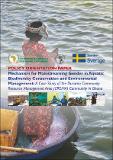Policy Orientation Paper: Mechanism for Mainstreaming Gender in Aquatic Biodiversity Conservation and Environmental Management: A case study of the Dusorno CREMA community in Ghana

(en=English; ar=Arabic; fr=French; pt=Portuguese)
Language
enDate
2024Author
AU-IBAR
Type
Policy BriefItem Usage Stats
238
views
views
33
downloads
downloads
Abstract
Aquatic biodiversity and its resources play a critical role in maintaining the health of both marine
and terrestrial ecosystems. However, these ecosystems are increasingly threatened by global
pressures including climate change, pollution, conflict, economic instability, and rapid population
growth. To address these complex challenges and ensure the sustainability of aquatic ecosystems,
there is a growing recognition within the conservation community of the need to involve vulnerable populations, particularly women and youth, in ecosystem management and restoration efforts. Women, in particular, often possess valuable knowledge about their natural environment due to their direct interaction with these resources over extended periods (AU-IBAR, 2022). Therefore, their active involvement and leadership are essential for effectively managing and improving aquatic ecosystems